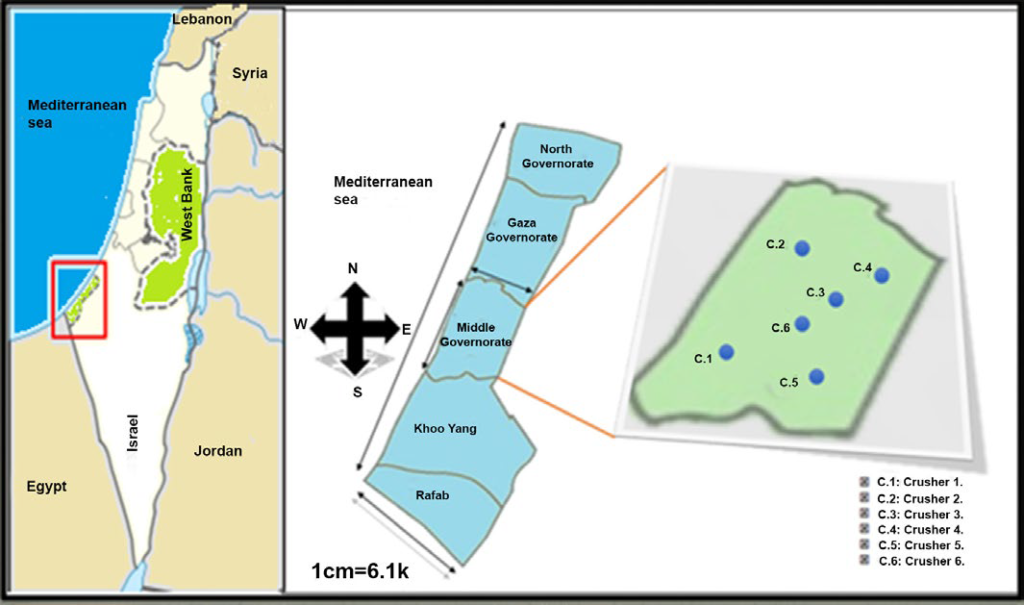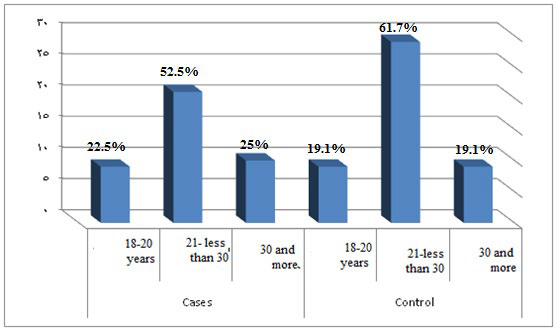BACKGROUND AND INTRODUCTION
Many studies have shown that acute exposure to PM10 is associated with leukocytosis (increasing white blood cells count). Studies have observed that long-term PM10 exposures are associated with CBC changes such as increasing white blood cells count.1,2,3,4
In 2007, the World Health Organization (WHO) released data on estimated deaths worldwide attributable to selected environmental risk factors including deaths per country per year as a result of outdoor air pollution.5
Worries that air pollution may have significant effects on health have recently been fuelled by publication of new evidence linking low levels of ambient air pollution with small public health effect. In order to suffer health effect, an individual who exposed to a pollutant and the pollutant must be able to reach those parts of the body that are vulnerable to its effect.
Because of the blockade as a result of disputed occupation of the Gaza governorates, and the large quantities of rubbles from building that destroyed by Israel bombardments during wars 2008, 2012, and 2014. The Palestinian owners of crushers plants using homemade crushers, was the only way to rebuild what was destroyed by the occupation in Gaza governorates.
The researchers attempt to measure the concentration of PM10 in crusher’s plants during operation and to examine effects on the complete blood counts that have occurred as a result of direct exposure of workers to particulate matter air pollution for contentious long hours of work. Due to that there is limited available data about the complete blood counts effects that caused to crushers workers, and limited available data associated with concentration of PM10 in crushers plants.
MATERIALS AND METHODS
The general objective of this study is to evaluate the level of PM10 air pollution in crushers plants, and their effects on complete blood count for crusher workers.
The target population of the study were (87) individuals. Case (exposed) group were 40, and control (non-exposed) group were 47. This case-control study was conducted between the participants who are under age of 15-65 and have no medical history and who works in crushers at Middle Governorate, and the participants those who are under the age of 15 years or more than 65, and have past medical history and do not work in the Middle Governorate were considered.
This case-control study was conducted during the period from April-August 2013 in gravel crushers, at Middle Governorate, Southern Governorates, Palestine.
Case Group (Exposed)
All workers in the six crushers at Middle Governorate who accomplished criteria, the number of workers is 40, as they worked in gravel crushers and continuously exposed to dust without using any protective devices, the exposed workers were male, their age ranged from 15-65 years, and does not have any past medical history.
Control Group (Non-exposed)
The control group contain 47 individuals who live in the same area of case group, their ages ranged from 15-65 years, do not have any past medical history, but they do not work in the gravel crushers.
Field and Laboratory Equipment
1. Hematology analyzer: A hematology analyzer is an instrument used to perform a complete blood count or full blood count (CBC or FBC).
2. HAL-HPC300 handheld optical particle counter.
3. PM10 measuring device were used for all crushers plants.
RESULTS
This study conducted on all crushers and workers who continuously exposed to dust without using any protective devices in the Middle Governorate which has six crushers distributed on all areas. (Figures 1-3)
Figure 1: The geographical distribution of crushers in Middle Governorate.

Figure 2: Concentrations of PM10 that emitted from six crushers and the average of these concentrations. PM10 air pollution monitoring data for the six crushers

Figure 3: Age of cases and control groups.

As shown in Figure (2) reveals that the emission of PM10 by the crushers varies widely from 10008 to 19807 μg/m3 , with an average particulate matter contribution of 15153 μg/m3 , which is about more than 100 times higher than the particulate matter (PM10) existing daily average standard of 150 μg/m3 . 6,7,8
The results in Figure (3) show the percentage of ages for both cases and control groups. Furthermore, it shows the elevated level of ages rapprochement between the two groups, which increase the accuracy of the study.
Results of Complete Blood Counts between Case Group (40) and Control Group (47) are shown in Table 1.
Table 1: The results of independent samples T-test for complete blood counts results between (40) case group and (47) control group.
|
CBC results
|
Groups |
N |
Mean |
SD |
T-Test value |
P-value
|
|
RBCS
|
Case
|
40 |
5.04 |
0.51 |
-1.260 |
0.211
|
|
Control
|
47 |
5.17 |
0.44
|
|
WBCS
|
Case |
40 |
8.67 |
1.24 |
6.975 |
0.000
|
|
Control
|
47 |
7.22 |
0.64
|
|
HGB
|
Case |
40 |
14.75 |
0.92 |
-1.170 |
0.245
|
|
Control
|
47 |
14.97 |
0.81
|
Red blood cells (RBCs):
The mean of RBCs for case and control group is (5.04, with SD of 0.51) and (5.17, with SD of 0.44), respectively. The value of the T-test equals -1.260, with p-value equals 0.211. This means that there is sufficient evidence to conclude that mean of RBCs is insignificantly different between the two groups. In other words, there is insignificant difference in the mean RBCs between case and control group.
White blood cells (WBCs):
The mean of WBCs for case and control group is (8.67, with SD of 1.24) and (7.22, with SD of 0.64), respectively. The value of the T-test equals 6.975, with p-value equals 0.000. This reveals that there is an evidence to conclude that mean of WBCs is significantly different between the two groups. Since the sign of the T-test is positive, then mean of WBCs for case group is significantly greater than control group.
Hemoglobin (HGB):
The mean of HGB for case and control group is (14.75, with SD of 0.92) and (14.97, with SD of 0.81), respectively. The value of the T-test equals -1.170, with p-value equals 0.245. This implies that there is sufficient evidence to conclude that mean of HGB is insignificantly different between the two groups. In other words, there is insignificant difference in the mean HGB between case group and control group.
DISCUSSION
Positive relationship is observed between PM10 air pollution and increasing White Blood Cells (WBCs) (leukocytosis) in this study. The statistical strength of relationship between PM10 air pollution exposure and increasing WBCs is in line with the study conducted by Tan, et al.4 have demonstrated leukocytosis in young military recruits exposed to an acute episode of particles air pollution during forest fires of south east Asia in the summer of 1997, suggesting that an episode of acute exposure to PM10 air pollution causes bone marrow stimulation in humans.2
Furthermore, Van and Tem studies showed that an acute exposure of PM10 air pollution causes leukocytosis in humans and proinflammatory cytokines in the blood collect in the south east Asia.2
This is supported by other independent longitudinal studies linking elevation of the peripheral blood count to increase mortality during exposure of PM10 air pollution. In consistent, Wells, et al. have shown that an increase in leukocyte count is predictor of total mortality, independent of smoking in large population-based studies9
Examination Survey in the United States, conducted among adults aged 20-89 years, which showed significant association between WBC count and estimated local PM10 levels during 1 year.3,10 Also, our findings are consistent with animal experiments showing an increase release of WBCs and their precursors from the bone marrow in response to the deposition of particles in the lungs.
These findings suggest that inflammatory mediators released from lung are capable of irritating not only a local inflammatory response, but also a systematic response when PM10 are deposited in the lungs, resulting in leukocytosis.
In the present study, it observed significant relationship between PM10 air pollution and increasing WBCs, these results are consistent with physiologic and related studies results. Insignificant relationships are observed between PM10 air pollution and hemoglobin and red blood cells.
A cross-over study among 29 participants with or without biking exercise and exposed to particulate air pollutants did not find any significant association of particulate air pollutants with hemoglobin, RBC and platelet count and markers of inflammation in healthy adolescents and childs.11
The associations of particulate air pollutants with hematologic parameters are consistent with the chronic effects of air pollutants on hematological factors.1
In the present study, it shows insignificant relationship due to the short duration of exposure to PM10 for target groups (1-3) years compared with appearance of significant impact on hemoglobin and red blood cells, which need long term period to appear clearly.
In summary, our findings are consistent with the results of studies that have mentioned and other, which showed positive and significant relationship between exposure of PM10 air pollution and increasing white blood cells (leukocytosis).
CONCLUSION
The particulate matter that emitted from the crushers varies widely from 10008 to 19807 μg/m3 , with an average particulate matter contribution of 15153 μg/m3 , which is about more than 100 times higher than the particulate matter (PM10) existing standard.
Increasing in white blood cells count reported in this study among the exposed workers. This increasing was found to be related to exposure of PM10 air pollution, as a result of the inflammatory process.
Data analysis shows insignificant relationship between (Red blood cells and Hemoglobin) and PM10 air pollution exposure, due to the short duration of exposure to PM10 for target groups (1-3) years compared with appearance of significant impact on hemoglobin and red blood cells, which need long term period to appear clearly.
CONFLICTS OF INTEREST
The authors declare that they have no conflicts of interest.
ACKNOWLEDGMENT
The authors reiterate their endless acknowledgement and high appreciation to all who helped in conducting this study.
CONSENT
The authors has received written permission for publication of the case details.








